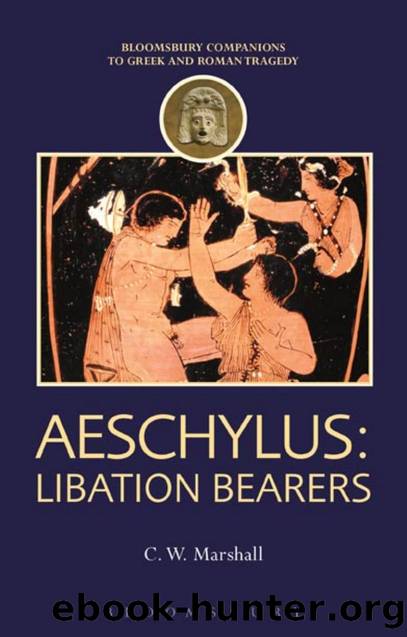Aeschylus: Libation Bearers by C. W. Marshall

Author:C. W. Marshall [Marshall, C. W.]
Language: eng
Format: epub
Tags: drama, Ancient & Classical, Literary Collections, Literary Criticism
ISBN: 9781474255073
Google: 54wEvgAACAAJ
Publisher: Bloomsbury
Published: 2017-09-07T01:03:03+00:00
Chorus and Character
87
Orestes and Pylades, of course, are armed with swords. All travellers would carry swords because the roads are wild. 37 And Orestesâ sword, forged by Destiny, will pierce lungs (very soon â¦) in a place where Justice has been trampled and Zeus, god of kingship, dishonoured.
Orestes holds the weapon, and he is the child: this is no longer figurative, especially if Orestes is still on stage. It is a brutal, beautiful hymn.
Stage directions must be inferred from the words spoken, and there is a unanimity of opinion at this point, reflected in all major translations, against which I would like to argue. It is usually thought that Orestes and Pylades retire along an eisodos when Electra leaves at 584, leaving the chorus alone on stage for the stasimon, and then return along the same eisodos and approach the palace door.38 This view holds that the performance space ârefocusesâ from the tomb of Agamemnon to the Palace at Argos (subsequently, the tomb is mentioned at 722â5). This refocusing is more problematic than is generally recognized, since it is not accompanied by an âempty stageâ, as at Eumenides 234, which allows for the transition from Delphi to Athens.
Orestes has outlined his plans to arrive at the palace with Pylades assuming the accent of a Phocian: this is to be his disguise. Does he alter his appearance further? I believe he does not. There are no special âPhocian garmentsâ he must put on. He is a traveller who has come on the road with luggage. He and Pylades have the broad-brimmed petasos that travellers habitually wore (see Chapter 2.1). He is unknown in Argos as an adult and already looks like a foreigner.
No further disguise is necessary. Once this is acknowledged, the need for Orestes and Pylades to leave and return similarly disappears. If they stay onstage, readying themselves at the centre of the orchÄstra while the chorus allusively sing about the evils women do, then at the final reference in strophÄ Î to Orestes and the sword of Justice, the meaning of the image becomes strikingly clear. The audience has seen
88
Aeschylus: Libation Bearers
their preparations (however minimal they were), and consequently is in the know, more closely allied to Orestes.
In this light, we should reconsider previous movements: Iâve suggested that the chorus and Electra make their initial appearance from the skÄnÄ which represented the palace, and it was to there that Electra returned at 584. Scholars who assume the scene must ârefocusâ
over the course of this stasimon often have the characters enter by an eisodos, but this creates a needless complication. Electra has to go to the palace on receiving Orestesâ instructions, and the clearest indication of where that is can be achieved by having her walk to the visible central door of the skÄnÄ. Using an eisodos requires the refocusing that others have postulated. With the continuous presence of the chorus, though, this is problematic.
On a non-naturalistic stage without defining or localizing details of setting, the distance that exists between
Download
This site does not store any files on its server. We only index and link to content provided by other sites. Please contact the content providers to delete copyright contents if any and email us, we'll remove relevant links or contents immediately.
The Power of Myth by Joseph Campbell & Bill Moyers(1000)
Half Moon Bay by Jonathan Kellerman & Jesse Kellerman(950)
A Social History of the Media by Peter Burke & Peter Burke(935)
Inseparable by Emma Donoghue(921)
The Nets of Modernism: Henry James, Virginia Woolf, James Joyce, and Sigmund Freud by Maud Ellmann(832)
The Spike by Mark Humphries;(764)
The Complete Correspondence 1928-1940 by Theodor W. Adorno & Walter Benjamin(746)
A Theory of Narrative Drawing by Simon Grennan(741)
Culture by Terry Eagleton(709)
Ideology by Eagleton Terry;(696)
Bodies from the Library 3 by Tony Medawar(679)
World Philology by(673)
Farnsworth's Classical English Rhetoric by Ward Farnsworth(671)
Game of Thrones and Philosophy by William Irwin(668)
High Albania by M. Edith Durham(654)
Adam Smith by Jonathan Conlin(647)
A Reader’s Companion to J. D. Salinger’s The Catcher in the Rye by Peter Beidler(642)
Comic Genius: Portraits of Funny People by(616)
Monkey King by Wu Cheng'en(609)
